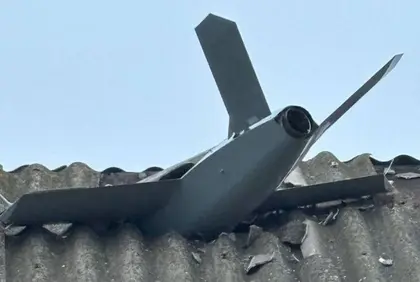A new Ukrainian jet-powered drone appears to have entered service, one of them having been spotted embedded in the roof of a building in the Russian-occupied Ukrainian city of Berdyansk.
The UJ-25 Skyline is the latest model of drone to enter Kyiv’s arsenal and marks a significant step up compared to its propellor-driven counterparts.
JOIN US ON TELEGRAM
Follow our coverage of the war on the @Kyivpost_official.
Being jet-propelled means increased range and speed and makes it more difficult for Russian air defenses to intercept.
There is one obvious concern with the specific drone pictured however – its warhead appears to have failed to detonate.
— Oriannalyla 🇺🇦 (@Lyla_lilas) December 22, 2023
The UJ-25 made its first public appearance in the background of a CNN interview with Ukraine’s Minister for Digital Transformation, Mykhailo Fedorov, back in September.
Full view on the Ukrainian UAV which was shown in recent CNN interview with the Minister of Digital Transformation of 🇺🇦. It’s name is UJ-25 Skyline. While it’s design is very similar to the UJ-23 Topaz, some differences are noticeable.
— Special Kherson Cat 🐈🇺🇦 (@bayraktar_1love) September 14, 2023
Full interview - https://t.co/asgVx2octU https://t.co/AZ8yXfz6vD pic.twitter.com/2fduCjLb3j
It is a modified version of a target drone, the Ukrjet UJ-23 Topaz, but beyond that not much is publicly known about the new drone other than what can be seen in the few pictures available.
Up until now, Ukraine has relied on propellor-driven drones such as the Beaver which have been targeting Moscow and occupied areas of Ukraine for months now.
The Bober, or “Beaver,” is a Ukrainian kamikaze drone, which began development in 2022. Fundraising for the creation of the Beaver drones was initiated on Twitter in December upon the request of Ukraine’s Main Intelligence Directorate (HUR) under the Ministry of Defense.

EU Transfers €1.5 Bln Raised From Russian Assets for Ukraine
Meanwhile, Russia continues to evolve its own attack drones, particularly the Iranian-made Shahed, and much more is known about these modifications.
Since their first appearance, the drones that have been recovered have shown technical modifications – some apparently by design, others forced upon the manufacturer by the necessity of compensating for components blocked by Western sanctions.
The engine
The motor in the original Iranian UAVs was a copy of the German Limbach Flugmotoren L-550 aircraft engine which Teheran calls the MADO MD-550. It is a four-cylinder two-stroke run on gasoline producing 50 bhp. The engines were fitted with Japanese or Irish carburetors and American-made servos, which were later replaced with Chinese versions to control the wings.
The Russian-produced drones use a Chinese copy of the original engine manufactured by the Beijing company MicroPilot UAV Flight Control Systems with a carburetors, servos and even spark plugs being sourced from a number of countries.
A Ukrainian technician examining the UAV said that it was difficult to find anything that had been manufactured in Russia on its engine, adding: “Even the starter button was made by the German company Bosch.”
Navigation
The original Shaheds employed inertial navigation blocks, manufactured in Canada, that relied on commercially available GPS systems for navigation with a limited CEP accuracy of around 10 to 15 meters. The Russian variants use the “Komet” navigation system, which incorporates GLONASS, Russia’s version of GPS for guidance. This is almost the only component of Russian production in these drones.
A recently recovered downed UAV was reported as being fitted with a SIM card linked to a Ukrainian provider and 4G modem. This was seen as probably an improvised Russian attempt to improve real-time guidance by using mobile phone communications towers for reduced reliance on satellite navigation for guidance and to stay one step ahead of possible electronic warfare capability.
As for electronics, both Iran and Russia are almost totally dependent on foreign products obtained through the black market. About 90 percent of chips and electrical parts found inside the drones are of Western manufacture.
Structure
The original Iranian design used a cast fiberglass body lined with a plastic printed honeycomb filler to hold internal components in place.
The newer Russian versions have a composite fuselage filled with a polyurethane-type filler, which is probably used to reduce costs as it seems to offer no operational or other advantage.
Ukrainian air defense teams began to report in early November that they noticed a number of Shaheds were “painted black,” which was assumed to be an attempt to make them less visible to mobile fire teams using cannon and guns to engage the UAV.
It soon became apparent that there was more to this “cosmetic” change: the coating and parts of the Russian-built drones contained carbon fibers which, when combined with the blended delta wing shape of the Shahed, was an attempt, according to Ukrainian Air Force spokesperson Yuriy Ihnat, to make the drones stealthier. The coating would act as both an absorbing material against radar signals and also dissipate some of the heat signature generated by the gasoline engine.
While this modification makes the Shaheds harder to spot on radar, giving defenders less time to engage them, events over the last few weeks suggest that engine noise and the use of searchlights allows them to be successfully engaged by machineguns alone.
Warhead
The standard warhead in the Iranian variant of the UAV is a high-explosive fragmentation charge weighing between 30 and 50 kilograms. A small number have been found with a columnar warhead around which were copper-lined shaped charges.
The Russian version seems to have a slightly smaller explosive charge around which have been packed tungsten ball bearings to act as shrapnel. This warhead weighs 40 kilograms and is believed to be a repurposed warhead from redundant air-launched missiles.
At the beginning of December, a recovered warhead was mis-identified as being a thermobaric warhead as used in the TOS-1, which works by dispersing an aerosol cloud of gas, liquid or powdered explosive with a significantly more energetic result than conventional explosives. This rumor was very quickly dispelled.
With an estimated cost of less than $50,000 and a claimed range of up to 2,000 kilometers, the Shaheds have proven a simple and cheap way for Russia to attack cities far beyond the frontline. They are likely to continue to be used to support the Kremlin’s attacks on Ukraine’s civilian infrastructure in conjunction with or as cost-effective substitutes for Russia’s dwindling stocks of missiles and other long-range weapons.
You can also highlight the text and press Ctrl + Enter






